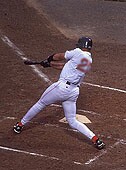- Understanding the Connection Between Anxiety and Depression
- How Daily Prunes Can Influence Cholesterol and Inflammation
- When to Take B12 for Better Absorption and Energy
- Epsom Salts: Health Benefits and Uses
- See What Saffron Can Do for Sleep and Heart Health
- 6 Common Mistakes to Avoid Before Your Physical
- Can Sweating Really Help You Beat a Cold?
- Strengthening Your Relationship: Practical Strategies
- Skip Storing This Everyday Product in the Fridge Door
- Green Tea + B3 Pairing May Boost Brain Health
Batters Mostly Use Their Heads to Track Pitches, Study Finds


TUESDAY, Jan. 14Baseball batters use a surprising amount of head movement to track pitches, according to a new study.
The findings offer information about how batters keep their eyes on the ball and could lead to new ways to help improve their ability to track pitches, wrote the researchers at the Ohio State University College of Optometry.
The researchers monitored the eye and head movements of 15 Division 1 collegiate baseball players as they tracked balls hurled by a pitching machine. The players’ eye and head movements were synchronized with the trajectory of the pitches.
“On average, eye-gaze position matched the target position well throughout the trajectory,” the researchers wrote.
For most of the time the ball was in the air, however, the players tracked it with their head. They moved their eyes very little until late in the pitch trajectory. The pitches took about 400 milliseconds (two-fifths of a second) to travel from the pitching machine to the batter, and the players did not move their eyes until between 340 and 380 milliseconds, the researchers found.
Head movements varied between players, but all of them seemed to use a strategy of “neural coupling” between eye and head movements in order to track the ball, according to the study, which was published online Jan. 3 in the journal Optometry and Vision Science.
“It will be interesting in the future to compare tracking strategies to hitting success, and tracking strategies of elite players to those of novice players,” the researchers said in a journal news release.
They also said this type of research could lead to improved vision-training strategies to help baseball players of all levels.
More information
The American Academy of Orthopaedic Surgeons offers baseball injury prevention tips.
Source: HealthDay
Copyright © 2026 HealthDay. All rights reserved.










